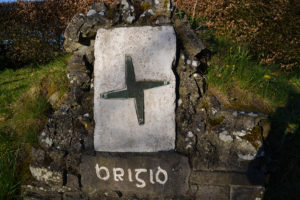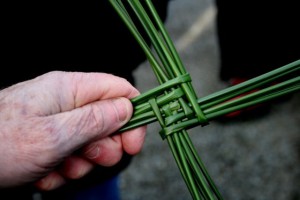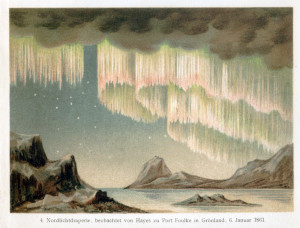Even in our contemporary, mostly urban, not so agrarian age, as distanced as we’ve become from nature and its rhythms, still, we have a pretty good understanding of the seasons. We know about solstices, we know about equinoxes, we know when spring has come and summer, fall, and winter. But we have, in general, lost touch with some handy units of measure: the cross quarter days. The cross quarter days mark the approximate halfway point between solstice and equinox. If we think of the year as a clock, and if we place the December solstice at 12 and the June solstice at 6, and if we place the March equinox at 3 and the September equinox at 9… well, we can divide things a little further and place the four cross quarter days at 1:30, 4:30, 7:30, and 10:30.
Traditionally, the cross quarter days are marked by holydays/holidays. The one we most recently celebrated was at the end of October and start of November: Halloween, All Saints Day, and All Souls Day––the Days of the Dead. We were approaching winter; life was descending below the earth. As February begins, we reach the next period of cross quarter days, marked by St. Brigid’s Day on the 1st and on the 2nd, Candlemas and Groundhog Day. This period marks the first stirrings of earth’s awakening on the approach to spring. Winter still has a firm grip, to be sure (it was 28 below zero at my aunt’s house in Illinois just last night)… but one thing to keep in mind with these traditional ways of reckoning time is they are always a small step ahead of the game. In this reckoning, the equinox in March will mark the height of spring… and so spring’s beginnings start here, as January melts into February. St. Brigid, sacred to Ireland and second in stature there only to St. Patrick, is honored on the First of the month. In the older earthbound religions, the day honors the Celtic goddess Brigid and brings the season of Imbolc. As the goddess goes, the old crone of winter is reborn now as the young maiden, for this is a time of renewal. The seeds that were planted beneath the earth last fall are preparing to bring forth lush green life, once spring truly arrives.
If you’ve been holding on to Christmas, this is the time to let it go. In some traditions, tonight marks the end of the Christmas season. Indeed, it is considered bad luck to have any remnants of Christmas greenery in the house beyond Candlemas Eve, which also comes this first night of February. Candlemas is the day that candles are blessed in the church, but it is also known as Purification Day, which harkens back to an old Hebrew tradition: forty days after the birth of a son, women would go to the temple to be purified. Again, renewal. And so Mary did this, for it was her tradition, and when she did, it was there at the temple that she and her infant child ran into the elders Simeon and Anna, who recognized the child as “the Light of the World.” Spring may be coming as we find ourselves forty days past midwinter, but the darkness of those darkest nights still closely lingers, and that light is still a powerful metaphor. One of my favorite Candlemas traditions is to go through the house at sunset, lighting every lamp, even for just a few minutes. Follow that with a meal of crepes (a European Candlemas tradition) or tamales and hot chocolate (the tradition in Mexico). One of the finest songs for this day and for those who follow these ways is an old carol called “Jesus, the Light of the World.” Candlemas is an old weather marker, too. As the old saying goes: If the sun shines bright on Candlemas day / The half of the winter’s not yet away. And while Candlemas itself is not paid much attention these days here in the States, this remnant of the day remains in our tradition of Groundhog Day.
The photo above is of St. Brigid’s Well at Cullion, County Westmeath, in Ireland. The cross above the name is a St. Brigid’s Cross, and it is traditional on her day to fashion crosses in this shape from reeds. Photograph by Laineylee [2015, Creative Commons, via Wikimedia Commons].


